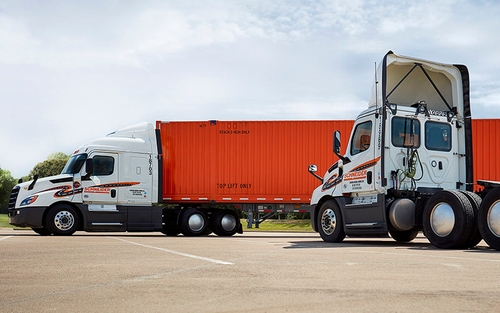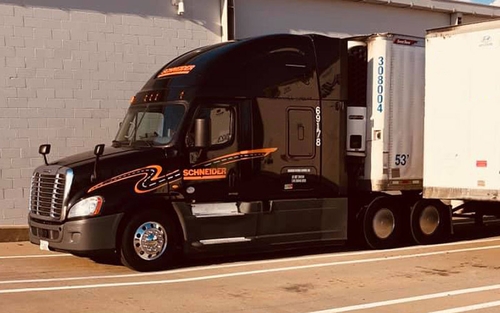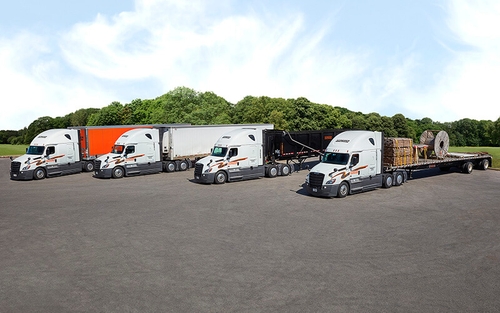Dry van versus reefer trucking jobs – What's the difference?


By The Schneider Guy
Estimated reading time: 2 minutes
Deciding between a reefer and dry van driving job? It's not always a clear-cut choice, as each has its own unique benefits and challenges.
Keep reading to learn more about the differences between dry van and reefer trucking jobs, and see which one could be right for you.
What is a reefer trailer?
Reefer trailers, short for refrigerated trailers, are designed to transport perishable goods that need to be kept at specific temperatures. Reefer trailers are equipped with a built-in temperature control unit that maintains the temperature of freight from the time it is loaded to the time it is delivered.
What is a dry van trailer?
Dry van trailers are used to transport a large selection of non-perishable goods in 53-foot trailers. Because of the versatility they offer, dry van trailers are by far the most used type of trailer in the trucking industry.
Reefer vs dry van driving jobs: 5 differences to know
While reefer and dry van driving jobs typically offer a similar overall experience compared to more unique opportunities like tanker or flatbed, there are some key differences to consider when choosing between the two:
1. Load types.
The main difference between hauling a reefer trailer and a dry van trailer is the freight.
Dry van trailers are used to haul a huge variety of goods, ranging from building materials and furniture to consumer goods and non-perishable food and beverages. In contrast, reefer trailers are used for perishable goods, such as produce, meat, pharmaceuticals and flowers.
2. Equipment.
While dry van and reefer trailers are both typically 53 feet long, reefer trailers have extra equipment that need to be maintained.
Some features specific to reefer trailers include:
- Trailer Refrigeration Unit (TRU): TRUs control and monitor the temperature of the trailer, whether that be cooling or warming the freight. TRUs consist of a small diesel engine and refrigerant compressor, with their own diesel fuel supply from a tank mounted under the trailer. Drivers can adjust the unit’s settings via a control panel on the driver’s side of the TRU.
- Insulation: Reefer trailers have walls insulated with foam and doors with air-tight seals to preserve the interior temperature.
- Ventilation systems: To maintain a constant temperature in the trailer, reefers often have an air delivery chute attached to the interior roof that evenly distributes the air within. Reefers also sometimes have metal channels in the floor that allow air to circulate evenly under the freight.
3. Responsibilities.
On top of the responsibilities that come with hauling a dry van trailer, drivers who haul reefer trailers also have to watch their trailer’s temperature at all times to make sure the freight doesn’t spoil.
Responsibilities can include:
- Following loading guidelines for proper airflow.
- Finding out what the temperature requirements of your next load will be head of time.
- Pre-cooling, if necessary.
Also, all the extra equipment on a reefer trailer requires routine inspection, adding more steps to a driver’s pre-trip inspection checklist.
4. Loading and unloading.
Though drop-and-hook loads exist for both dry van and reefer jobs, drivers who haul reefer trailers are a little more likely to encounter live loads and unloads due to the temperature sensitivity of the freight they hauled.
5. Cleaning.
Some reefer loads are prone to leaving wet spots and spills in drivers’ trailers. When these spills come from goods like meat or dairy, they can leave behind dangerous bacteria that could contaminate future loads.
After certain deliveries, reefer drivers may need to wash out their trailer in addition to sweeping out the hazards that dry van drivers also deal with, such as:
- Nails.
- Screws.
- Wood pieces.
- Other debris.
Curious about other trucking jobs?

Schneider Guy loves the "Big Orange." He's passionate about the trucking industry and connecting people to rewarding careers within it. He's been the eyes and ears of our company since our founding in 1935, and he's excited to interact with prospective and current Schneider associates through "A Slice of Orange."



